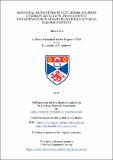Individual recognition in bottlenose dolphins (Tursiops truncatus): From acoustic distinctiveness in signature whistles to visual self-recognition
Abstract
Recognition is a crucial process in animal social interactions and communication. Despite
numerous contributions on recognition processes in a wide variety of species, the field lacks a
comprehensive review, as well as an ordering structure and clear definitions. I introduce the
ordering principles of signal modality and social level to increase comparability of studies,
avoid confusion within the field, and guide future research. Careful consideration of these
principles may be revealing: For example, recognition on a group level (e.g. kin-recognition)
might be based on individual recognition, where the receiver recognises a sender based on
individually distinctive cues. While individual recognition has been demonstrated in many
species, little is known about the development of individual recognition signals and the roles
genetics, maturation and learning play. Here, I focus on signature whistles, an acoustic signal
for individual recognition in bottlenose dolphins. I analyse the whistle development of dolphin
calves during ontogeny to calculate the time when the signal stabilises enough to function as a
reliable recognition signal. Other means of individual recognition are explored by considering
variation and changes in acoustic parameters. Previous studies suggested that vocal
production learning might matter in signature whistle development. I show that dolphins use
model-sounds from their environment, which provides evidence for vocal production learning.
Self-recognition is a special form of individual recognition, where the same individual is both
the signaller and receiver. Successful self-recognition has been suspected to be an important
evolutionary step towards consciousness, but was long thought to be absent in animals other
than great apes. While dolphins were considered promising candidates, the established
method was not suitable to test marine mammals. I introduce an adjusted method, discuss the
pitfalls of the mark test, and present first evidence for mirror-guided self-inspection in
bottlenose dolphins.
Type
Thesis, PhD Doctor of Philosophy
Rights
Attribution-NonCommercial-NoDerivatives 4.0 International
http://creativecommons.org/licenses/by-nc-nd/4.0/
Collections
Except where otherwise noted within the work, this item's licence for re-use is described as Attribution-NonCommercial-NoDerivatives 4.0 International
Items in the St Andrews Research Repository are protected by copyright, with all rights reserved, unless otherwise indicated.


